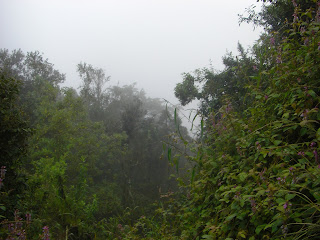Nestled in the frozen elevations of the Tanzanian highlands is the small village of Mchanganye. It is a remarkable village, full of landscaped paths and brightly painted buildings unusual for the typical rustic life of the country. But perhaps most remarkable is that it thrives in the shadow of an ancient volcano who's caldera now houses a giant lake known in the local language as the Big One [Ngozi] or sometimes Hema Hema [movement] for its habit of shifting its shape. The wooded slopes of this long-defunct fiery mountain are known for housing primates that were, until quite recently, unknown to the people of science. Being in the area, I was naturally curious about the place, and so I wrote to a lady I know who makes her home there, suggesting an expedition to the lake in the crater. Receiving a favorable reply, I set out with a few friends in order to investigate.
At the beginning, spirits were high, nonetheless, from the beginning we were beset by troubling signs of decay. The path was marked by an ancient, decrepit guardhouse in which we signed our names in an ancient and decrepit gatehouse, under the eye of a tired, unwashed man. Just outside the guardhouse, the cheerful flowers planted long ago were swarmed with shining voracious insects.
Further down the path we found ourselves enchanted by flashed of color from the many butterflies, but the only specimen we could come close to clutched itself close to the ground, broken wing dangling.
After some fifteen minutes of easy promenade, we found ourselves in dense forest, and the light diminishing into a grey diffuse haze as a cloud bank settled and began to envelope us in dripping fog.
Leaping white-faced friend
High above the dripping path,
We're glad we met you.
Even my profound optimism began to be shaken as we proceeded into a forest of banana trees. Cursed trees, doomed to die after their first and only fruiting, leaving their slimy curved rotting trunks in the forest detritus beneath our feet! Unhappy trees, of a monstrous and forbidding height, that we have no choice but to pass beneath with shudders.
 |
| Demonstrating the prodigious size of this monstrous vegetation. |
These banana trees
Live only to bear fruit once
Before death and rot.
As we proceeded up the slope of the mountain, the mist set in fast around us, and while I noted with alarm the increased abundance of spiders, I attempted to calm my fears by reflecting on the mist-ensparkled webbing and the perfection of the webs.
As we left the banana trees and entered a bamboo forest, I became thoroughly alarmed by the prevalence of fallen trees forming unnaturally perfect bridges across the path. Though I jocularly referred to these as troll bridges, I was far from easy in my mind about these strange structures in a forest increasingly misted into darkness.
At last we reached the lip of the crater, and straining, we saw...nothing. Nothing but a bed of roiling mist, hiding everything in our view. Peering intently, I thought I saw movement deep within the mists. I recoiled with a cry, but my companions, seeing nothing, soon convinced me that it was just my old nervous troubles and I should relax and photograph the flowers.
 |
| Where the lake would have been could we have seen it. |
 |
| One of my completely relaxed companions. |
I attempted to emulate my more sanguine companions by occupying my mind and my hands to write the following:
Past the mossy dark,
Beneath the arching troll-paths,
A lake lost in mist.
Normally, bus preachers are a source of great fascination to me. Bus preaching is, of course, an activity that is at best rude, but I still find it an amusing novelty.
As I listened to the man, providing a running and somewhat cynical translation (God hates booze is possibly not the best translation for mungu hataki pombe) for one of my companions who is less adept in the language, I realized he was talking about people burning in fire (either historical inhabitants of Sodom or proponents of anal sex in future hell) and he was smiling at me. I stared in hypnotic fascination as the smile grew ever broader while he spoke of fiery death, and while I stared, his face seemed to morph into the white furred mask of the non-photographable monkey we had encountered on the path to the crater. A horror of blasphemous things unimaginable filled my soul, and I began, for the first time, to suspect the full truth of the things living on the slopes of a mountain that used to weep fire. I closed my eyes in horror and waited for the end.



















You seem to have morphed into the Howard Phillips Lovecraft of the Piece Corps. Even the place names sound like unpronouncelable Lovecraft-ian names.
ReplyDeletePerhaps you will get to meet the Crawling Chaos before your hitch is over.
I can't take credit for the place names, as they are the actual real names in Kiswahili and Kisafwa (the local tribal language), but I am so hoping to meet the Crawling Chaos. Or better yet, the Black Goat of the Woods with a Thousand Young. There are plenty of goats here already, so I figure my odds are good.
ReplyDeleteHe's called The Crawling Chaos because he can't walk yet.
ReplyDeletehttp://www.youtube.com/watch?v=FOHJUrcVdJk